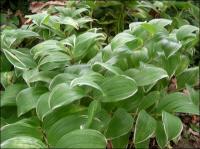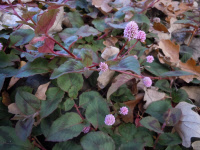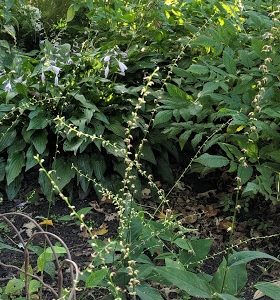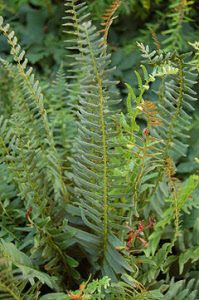Shop
Showing 577–584 of 788 results
-
Polemonium reptans Greek valerian, Jacobs ladder Z 3-8
Opposite leaves grow up the foot-tall stems forming a ladder to the tops where sprays of five-petaled lavender-blue bells with bright yellow stamens, bloom in spring. Repeats if deadheaded and may self-sow if not cut back.
Opposite leaves grow up the foot-tall stems forming a ladder to the tops where sprays of five-petaled lavender-blue bells with bright yellow stamens, bloom in spring. Repeats if deadheaded and may self-sow if not cut back.
Size: 8-12” x 10”
Care: part shade in moist to moist well-drained soil
Native: Ontario & Quebec to Alabama, west to MN & KS, Wisconsin native
Wildlife Value: attracts bees, butterflies and wasps. Tolerates walnut, resists deer.Polemonium is Greek meaning “to wage war,” “on account of the contests, which arose betwixt two princes, each assuming the honour of the discovery of it to himself.” Gardeners Dictionary, 1768. Meskwaki made a compound of roots of this plant as a physic and urinary problem remedy. Collected for gardens before 1750.
-
Pollia japonica Z 5-8 Yabumyooga in Japanese
Whorls of white flowers on a stalk above foliage blooming in July-August turn to blue berries in fall, oblong, foot-long, shiny foliage resembling ginger leaves.
ARCHIVED
Note: This is a plant not currently for sale. This is an archive page preserved for informational use.
Whorls of white flowers on a stalk above foliage blooming in July-August turn to blue berries in fall, oblong, foot-long, shiny foliage resembling ginger leaves.
Size: 1-3’ x 1-3’ spreads by rhizomes
Care: part to full shade in medium to moist soil
Native: Forests in China, Taiwan, Korea and JapanCollected by Thunberg by 1784. Used medicinally in Asia to treat colds and vertigo.
-
Polygonatum biflorum Solomon’s seal syn. P. commutatum Z 3-9
Small white bells dangle from the arching stems in June followed by black fruit of berries.
Small white bells dangle from the arching stems in June followed by black fruit of berries.
Size: 2-5’ x 2’
Care: shade in well-drained soil. Good dry shade plant.
Native: So. Canada and northern U.S., WisconsinDioscorides named Polygonatum in the 1st century, which means “many jointed” referring to scars on the rhizome. Used medicinally by the Cherokee, Chippewa and Menominee for dysentery, stomachaches, breast and lung disease and for “general debility.” It put Chippewa to sleep but revived unconscious Menominee. HoChunk added cooked and dried root to soups. Lakota Sioux: “The rhizomes are een soups and stews. They are also dried for later use. The young shoots can be eaten raw or cooked but seeds and fruits are considered toxic.” P. biflorum grown in American gardens since 1700’s.
-
Polygonatum falcatum var. variegatum Variegated Solomon seal Z 4-9
Gracefully arching Solomon seal with white margined leaves and white bells dangling from each leaf axil in spring
Gracefully arching Solomon seal with white margined leaves and white bells dangling from each leaf axil in spring
Size: 20" x 4' slow spreader
Care: moist to moist well-drained soil in shade.
Native: Japan
Wildlife Value: Birds eat the fruit. Pollen and nectar feed a number of bee species.
Awards: Great Plant Pick Award; Perennial Plant Assn’s 2013 Plant of the Year; Missouri Botanic Garden Plant of Merit, Great Plants for Great Plains, Pennsylvania Horticultural Society Gold Medal1st identified by Japanese botanist Takenoshin Nakai (1882-1952) in “Botany Magazine of Tokyo” 1924.
-
Polygonatum multiflorum Solomon’s seal Z 4-10
Dangling dainty white bells in June followed by black fruit on the arching stem. The leaves “make a fine mass of elegant foliage,” Sanders, 1913.
Dangling dainty white bells in June followed by black fruit on the arching stem. The leaves “make a fine mass of elegant foliage,” Sanders, 1913.
Size: 5' x 10"
Care: shade in fertile, humusy, well-drained soil. Good dry shade plant
Native: Europe and AsiaGreek physician Dioscorides named Polygonatum in the 1st century, which means “many jointed” referring to scars on the rhizome. Medieval herbalists opined that Biblical figure Solomon put scars on the rhizome to demonstrate the plant’s curative powers. P. multiflorum cultivated in English gardens by 1450. In 1596 English herbalist Gerard endorsed its use to repair broken bones – mix the pulverized root and drink it with ale to “gleweth together the bones in very short space.” He also claimed fresh stamped root of Polygonatum would cure cuts and bruises for “women’s willfulness in stumbling on their hasty husband’s fists.” According to Culpepper, Italian wives “much used” this remedy. American gardens since 1700’s.
-
Polygonum capitatum Pinkhead knotweed, in China tou hua liao. Z 7-11 Reseeding annual in colder areas. Reseeds generously but not until it warms in late spring or early summer.
Petite, oval-shaped spikes of pink flower heads June through October, with ornamental, chevron-like pattern on the leaves. Wonderful groundcover, good for rock gardens and containers and between stepping stones and anyplace you want to put a plant.
Petite, oval-shaped spikes of pink flower heads June through October, with ornamental, chevron-like pattern on the leaves. Wonderful groundcover, good for rock gardens and containers and between stepping stones and anyplace you want to put a plant.
Size: 5” x 12”
Care: sun to part shade in moist to moist well-drained soil
Native: China, Thailand, Vietnam, Afghanistan, Malaysia & NepalCollected for western gardens by 1825. Used medicinally in Asia. Polygonum from Greek polys meaning “many” and gonu for “knee” or “joint” for the thickened joints on the stem. Capitatum means “dense head.”
-
Polygonum virginianum syn. Persicaria virginiana Jumpseed Z 4-8
Arresting tiny white flowers atop nearly leafless stems blooming late summer into fall; dark green foliage marked with a maroon chevron on each leaf
ARCHIVED
Note: This is a plant not currently for sale. This is an archive page preserved for informational use.
Arresting tiny white flowers atop nearly leafless stems blooming late summer into fall;
dark green foliage marked with a maroon chevron on each leafSize: 2-3’ x 3-4’
Care: shade to part shade in moist to moist well-drained soil
Native: All eastern areas from central Canada south to Texas, Wisconsin native
Wildlife Value: attracts birds, bees & butterflies, Deer resistant
Size: Cherokee made a hot infusion of leaves with the bark of a Honey Locust to treat whooping cough.Linnaeus 1753.
-
Polystichum acrostichoides Christmas fern Z 3-10
Leathery, lance-shaped evergreen fronds stay fresh and green through winter.
OUT OF STOCK
Leathery, lance-shaped evergreen fronds stay fresh and green through winter.
Size: 18" x 18"
Care: part shade to full shade in most any soil, nearly indestructable
Native: Every state east of the Rockies, Wisconsin native
Awards: Kentucky's Theodore Klein Plant AwardEvergreen fronds last all winter. Called “Christmas” because in the past florists used the evergreen fronds in holiday arrangements. Collected by Michaux before 1800. Collected by French botanist and plant hunter André Michaux (1746-1802) while searching east of the Mississippi River before 1800.
**LISTED AS OUT OF STOCK BECAUSE WE DO NOT SHIP THIS ITEM. IT IS AVAILABLE FOR PURCHASE AT OUR RETAIL LOCATION.







